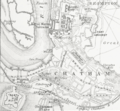Fort Pitt, Kent facts for kids
Fort Pitt is an old fort built during the Napoleonic Wars. It stands on high ground between Chatham and Rochester, in Kent. People first thought about building a fort here in the 1790s. It was finally built between 1805 and 1819.
The fort was never fully used for fighting. Instead, it became a hospital. Today, it is a girls' grammar school.
Contents
History
Building the Fort
Fort Pitt was named after William Pitt the Younger, who was a Prime Minister of Britain. It was part of a group of defenses that watched over the River Medway. Other forts like Fort Clarence and Fort Amherst, along with the Great Lines, could be seen from Fort Pitt. All these places worked together to protect Chatham Dockyard, which was a very important naval base.
The fort had strong red-brick walls with a bastion (a pointy part of the wall) at each corner. A deep trench, about 15 feet (4.6 meters) deep, surrounded the fort for protection.
The original fort had several buildings that are no longer there. These included a central tower, which was removed in 1910 to make more space for the hospital. There was also a large blockhouse that could house 500 soldiers. Two smaller towers, called 'Delce' and 'Gibraltar', stood on each side. Gibraltar Tower was pulled down in 1879, and Delce Tower, which was already a ruin, was probably removed soon after. The large blockhouse was taken down in the early 1930s.
A Hospital for Soldiers
The Napoleonic Wars ended, so Fort Pitt was not needed as a fighting fort. However, soldiers sometimes stayed there. In 1815, wounded soldiers from the famous Battle of Waterloo were brought here.
In 1828, Fort Pitt became a place for soldiers who were too sick or hurt to fight. It officially became a military hospital in 1832. A special hospital for soldiers with mental health needs was added in 1847.
By the 1850s, Fort Pitt was a very important military hospital. Most soldiers who were sent back to Britain from other countries because they were sick or wounded were checked here before they left the army. This included many soldiers from the Crimean War and the Indian Mutiny.
Queen Victoria herself visited Fort Pitt three times in 1855 to see the soldiers wounded in the Crimea. In 1860, Florence Nightingale, a famous nurse, chose Fort Pitt as the first home for the new Army Medical School. This school later moved to Netley in 1863.
Fort Pitt continued to be a hospital for soldiers. In October 1914, King George V and Queen Mary visited. They met servicemen wounded in the First World War, including five German naval officers. At least seventy German prisoners were treated at the Fort. After they got better, they were kept in the Blockhouse until the war ended. The hospital finally closed in 1919.
Fort Pitt Today
In 1929, the Chatham Education Board bought the empty Fort Pitt from the War Office. The site was then turned into a Girls' Technical School. The school, now known as Fort Pitt Grammar School, is still on the site. It has added several new buildings over the years.
The building next door, which belongs to the University for the Creative Arts, stands where the old blockhouse used to be. You can still see some of the original brickwork on the sides of this building.
Fort Pitt is still a very important historical site. The Music House (which used to be the hospital for soldiers with mental health needs) and the “Crimea Wing” teaching block are listed buildings. You can even see some of the old hospital ward numbers on the walls of the Crimea Wing. Several other buildings are also very old, possibly from when the fort was first built. Sadly, part of the old hospital building was destroyed in a fire in 1973. Much of the fort's outer walls still stand, including parts of the defenses that go into the nearby recreation grounds.
Military Cemetery
The Fort Pitt Military Cemetery is about a quarter of a mile south of the fort, near the A229 road from Rochester to Maidstone. This cemetery was created to serve the hospital. It has graves from the mid-1800s onwards. These include 290 graves of soldiers from the World Wars. 265 of them are from World War I, and 25 are from World War II.
In Literature
When he was a boy, the famous writer Charles Dickens lived very close to Fort Pitt. In his novel The Posthumous Papers of the Pickwick Club, the fort is the place where a pretend fight happens between Mr. Nathaniel Winkle and Dr. Slammer.
Images for kids
-
Chatham Dockyard and Fort Amherst from Fort Pitt, view to north, 1831









